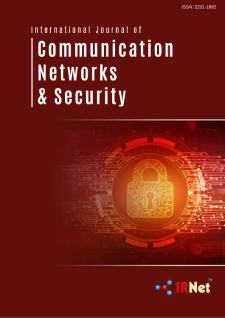International Journal of Communication Networks and Security IJCNS
ISSN: 2231-1882

Abstracting and Indexing


IJCNS
IMPROVED KERNEL FUZZY ADAPTIVE THRESHOLD ALGORITHM ON LEVEL SET METHOD FOR IMAGE SEGMENTATION
TARA. SAIKUMAR
Dept of ECE, CMR Technical Campus, Hyderabad, India
S. AMIT
Dept of ECE, CMR Technical Campus, Hyderabad, India
Y. DINESH
Dept of ECE, CMR Technical Campus, Hyderabad, India
Abstract
Using thresholding method to segment an image, a fixed threshold is not suitable if the background is rough Here, we propose a new adaptive thresholding method using level set theory. The method requires only one parameter to be selected and the adaptive threshold surface can be found automatically from the original image. An adaptive thresholding scheme using adaptive tracking and morphological filtering. The Improved Kernel fuzzy c-means (IKFCM) was used to generate an initial contour curve which overcomes leaking at the boundary during the curve propagation. IKFCM algorithm computes the fuzzy membership values for each pixel. On the basis of IKFCM the edge indicator function was redefined. Using the edge indicator function of a image was performed to extract the boundaries of objects on the basis of the presegmentation. Therefore, the proposed method is computationally efficient. Our method is good for detecting large and small images concurrently. It is also efficient to denoise and enhance the responses of images with low local contrast can be detected. The efficiency and accuracy of the algorithm is demonstrated by the experiments on the images. The above process of segmentation showed a considerable improvement in the evolution of the level set function.
Recommended Citation
[1] A. Shio, “An Automatic Thresholding Algorithm Based On An Illumination-Independent Contrast Measure”, IEEE Computer Society Conference on Computer Vision and Pattern Recognition, pp. 632-637, 4-8 June 1989. [2] N. Otsu, “A Threshold Selection Method from Gray-Level Histogram”, IEEE Trans. on System Man Cybernetics, SMC, vol. 9(I), pp. 62-66, 1979. [3] F.H.Y. Chan, F.K. Lam, Hui Zhu, “Adaptive Thresholding By Variational Method”, IEEE Transactions on Image Processing, vol. 7, no. 3, pp. 468-473, March 1998.[4] Osher, S., and Sethian J.A., “Front Propagating with Curvature-Dependent Speed: Algorithms Based on Hamilton-Jacobi Formulations”, Journal of Computational Physics, 79, pp. 12-49, 1988. [5] Osher, S., and Sethian J.A., “Front Propagating with Curvature-Dependent Speed: Algorithms Based on Hamilton-Jacobi Formulations”, Journal of Computational Physics, 79, pp. 12-49, 1988. [6] Malladi,R.,Sethain,J. and Vemuri,B., “Shape modelling with front propagation: A level set approach”. IEEE Trans.Pattern Analysis and Machine .Intelligence, pp.158- 174,1995. [7] L. Staib, X. Zeng, R. Schultz and J. Duncan. “Shape Constraints in Deformable Models”. In Handbook of Medical Imaging, I. Bankman (ed.), Academic Press, chapter 9, pp 147-157, 2000. [8] Leventon.M, Faugeraus.O, Grimson.W, and Wells.W, “Level set based segmentation with intensity and curvature priors”. IEEE Workshop on Mathematical Methods in Biomedical Image Analysis Proceedings, pp.4-11,2000. [9] Paragios.N, Deriche. R, “Geodesic active contours and level sets for the detection and tracking of moving objects”. IEEE Transaction on pattern Analysis and Machine Intelligence, pp.266-280 Mar 2000. [10] Vese .L .A, Chan .T. F, “A multiphase level set frame wor for image segmentation using the mumford and shah model”. International Journal of Computer Vision, vol 50 no 3,pp.271-293,2002. [11] D. L. Milgram, “Region Extraction Using Convergent Evidence”, IEEE Trans. on Computer Graphics and Image Processing, vol. 11 no. 1, 1979. [12] S. D. Yanowitz and A. M. Bruckstein, “A New Method For Image Segmentation”, IEEE Trans. on Computer. Vision, Graphic and Image Processing, vol. 46, pp. 82-95, 1989. [13] Li C., Xu C., Gui C., Fox, MD: “Level set evolution without re-initialization:a new varitional formulation”. IEEE Computer Society Conference on Computer Vision and pattern Recognition,pp.430-436,2005. [14] Bezedek J., “A convergence thheorem for the fuzzy ISODATA clustering algorthims”. IEEE Trans.Pattern Analysis and Machine Intelligence,pp 78-82,1980. [15] S.Osher and R.Fedkiw, “Level set methods and Dynamic implicit surfaces”,Springer,vol 57, issue 3, pp.112- 113,2002. [16] D.Peng,B.Merriman,S.Osher,H.Zhao, and M.Kang, “A PDE- based fast local level set method”, Journal of Computational Physics,vol 155,issue 2,pp.410-438,1996. [17] J. C. Bezdek, “Pattern Recognition with Fuzzy Objective Function Algorithms’’. Plenum Press, New-York, 1981. [18] K.L.Wu, and M.S.Yang, “Alternative c-means clustering algorthims”,Pattern Recognition, vol.35, pp.2267- 2278,2002. [19] T. McInerney and D. Terzopoulos, "Deformable models in medical image analysis: a survey," Medical Image Analysis, vol. 1, no. 2, pp. 91-108, 1996. [20] J.Gomes and O.Faugeras, “Reconciling distance functions and Level Sets”, J.Visual Communic. And Image Representation,vol 11, pp.209-223,2000. [21] Zhang, L., Zhou,W.D., Jiao. L.C.: “Kernel Clustering Algorithm”. Chinese J. Computers, vol25 (6), pp. 587-590, 2002 .